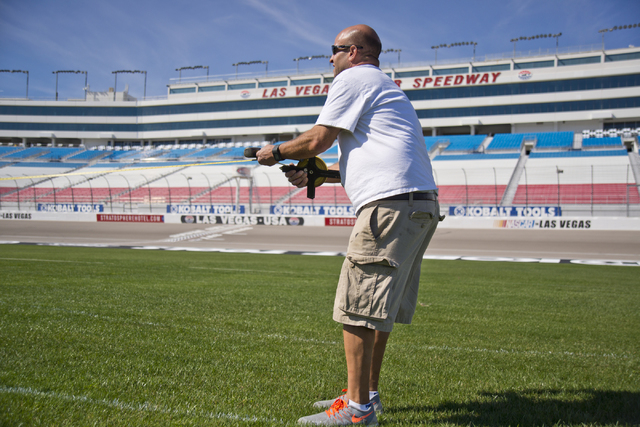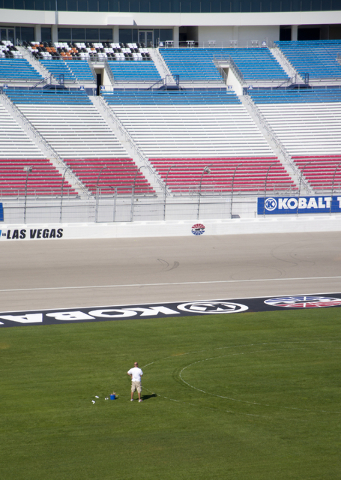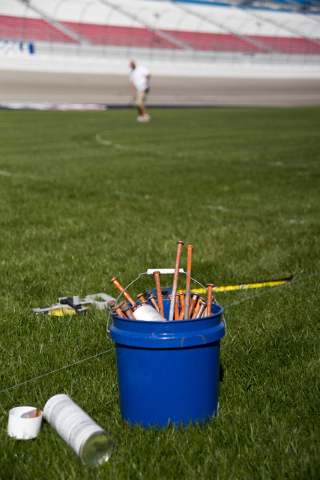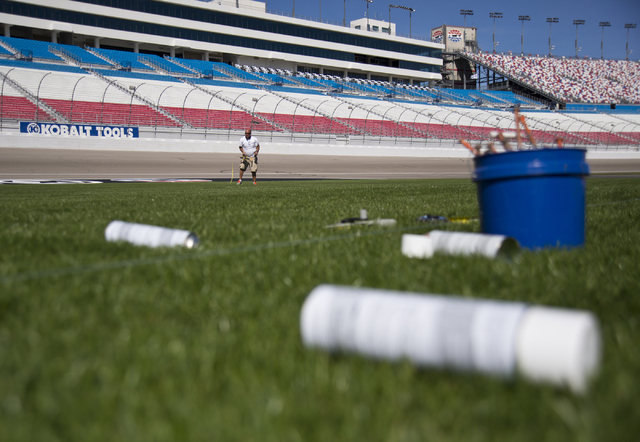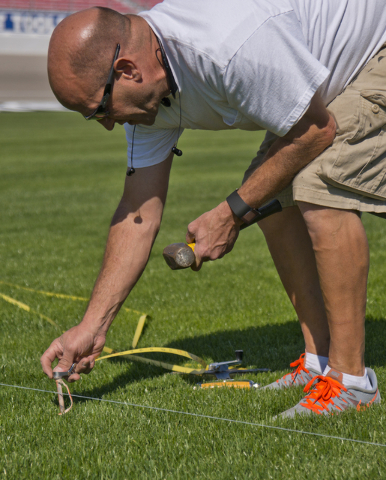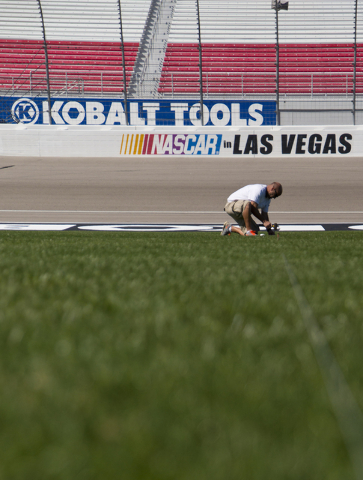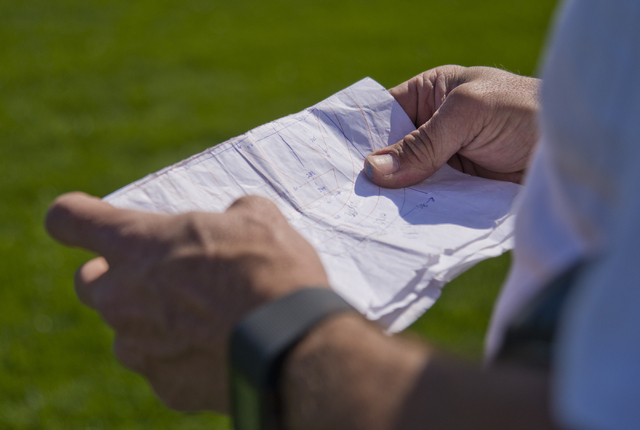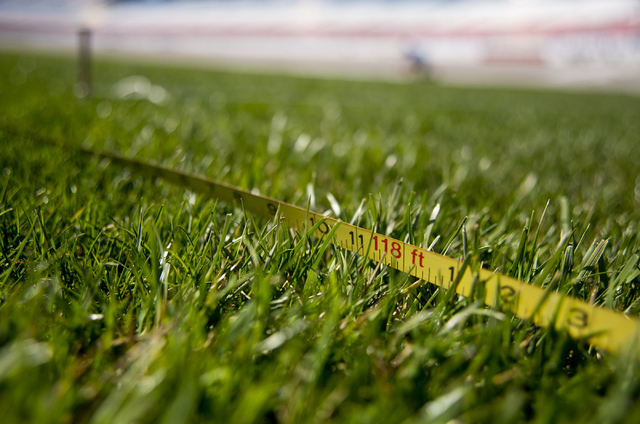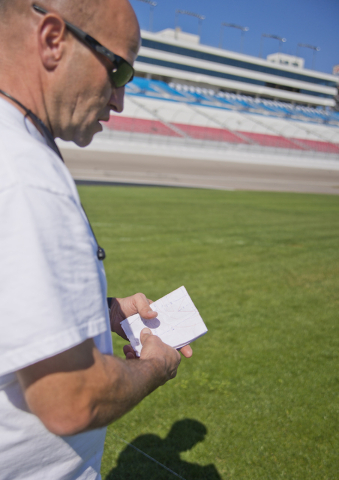Grassy areas at Las Vegas Motor Speedway might be danger zone for NASCAR drivers
So, a few haulers of green paint won’t suffice?
You might even get Dunn-Edwards to throw in all the materials as a little trade deal for adding its logo to the asphalt at all tracks because Lord knows how much NASCAR loves to splash sponsors across any available surface.
I understand the part about being aesthetically pleasing to the viewing audience. The wife has made our backyard into a dazzling desert landscape of fruit trees and bird baths and various plants and rocks, and yet the only one risking severe injury (in this case a bad back from sleeping on the couch) is yours truly when forgetting to turn off the grill’s gas line.
Things get a little dicier when a race car hits grass at 150 mph.
The barriers are safer, those head-and-neck restraints have reduced the likelihood of catastrophic injury, and it’s true those running the world’s largest governing body for stock car racing have over the past decade made it so those turning left have a better chance than ever to remain unharmed.
But the suits can and should do more.
They need to eliminate all that grass.
I don’t think much about splitters because my leisurely travels along Summerlin Parkway in a trusty 2011 Hyundai rarely raise many red flags about things like essential aerodynamic components to help balance distribution of downforce. But I can see how a device on race cars that appears as if it’s always about to scrape the track surface sure could cause havoc when digging into grass at unearthly speeds.
A shovel of death.
“I mean, I’ve been trying to bang that drum for a long time,” six-time Sprint Cup Series champion Jimmie Johnson said at Daytona International Speedway last month. “I’ve talked to track owners, operators about it. I just think we would have a much better race if the grass wasn’t there. Grass doesn’t slow you down like asphalt does.”
NASCAR has this way of fixing what needs to be fixed in the moment, but rarely reaching beyond the intended mission of specific improvement. It’s true that things are safer now than at any point in the sport’s history, but why not eliminate possible tragedy in a specific area before it leads to a funeral?
I know glistening green grass looks great on TV, but is it more important than staring at a brown casket?
You would have thought Kyle Busch’s impact in the Xfinity race at Daytona last year — when his car never slowed while sliding through grass near Turn 1 before slamming into a concrete retaining wall, like a rock skimming across a pond — might have softened what can be some pretty stubborn folks among NASCAR’s brass when it comes to removing all grass.
Busch broke his right leg and left foot, missing the season’s first 11 Sprint Cup races, and Daytona responded by installing 200,000 square feet of asphalt, primarily in the area he crashed, while also adding more energy-absorbing SAFER Barrier walls.
Again, change, but not a total overhaul.
The Xfinity Series Boyd Gaming 300 is today and the Sprint Cup Series Kobalt 400 on Sunday at Las Vegas Motor Speedway, which has about 4 acres of grass on the front stretch between the start-finish line and pit row.
It’s true grass plays well and serves a major purpose for the Electric Daisy Carnival and corporate functions also hosted by the speedway. But I have to believe other temporary turf options could be installed to appease clients and music festival fans for the sake of making things safer for drivers.
As it is, Las Vegas Motor Speedway follows the lead of most all tracks, which means it makes any changes NASCAR demands. It’s told to do something and does it.
“Grass is never good,” driver Greg Biffle said. “You’ve got no control. You have no idea where you’re going. So race cars and grass don’t do well together. The more pavement and runoff area you have, the safer you’re going to create it.
“It’s that simple. It’s a formula. The more pavement you have, the safer it can be because it gives you a chance to stop your car.”
There is hope among some drivers that NASCAR’s longstanding closed-door policy about such matters has softened, that more and more those who run the sport are listening to those who make it. Tragedy has struck other series when it comes to this stuff. Deaths have been linked to cars flipping once digging into grass.
I’m all for things looking nice and pretty, and realize how much that matters to sponsors writing enormous checks, and NASCAR hasn’t had a death of a driver in one of its three major series since Dale Earnhardt crashed on the final lap of the Daytona 500 in 2001.
But removing grass doesn’t mean tracks have to become massive structures of gray. Get the creative juices flowing. Break out some paint. Plaster some colorful sponsor logos for millions of dollars where the glistening green stuff now sits across a nation of tracks.
That way, maybe NASCAR won’t have to try to explain any brown caskets.
Ed Graney can be reached at egraney@reviewjournal.com or 702-383-4618. He can be a heard on “Seat and Ed” on Fox Sports 1340 from 2 p.m. to 4 p.m. Monday through Friday. On Twitter: @edgraney.



